Are you a Quiet Speculation member?
If not, now is a perfect time to join up! Our powerful tools, breaking-news analysis, and exclusive Discord channel will make sure you stay up to date and ahead of the curve.
I'm a firm believer in playing what you love in Modern, and in Magic. For me, that often means Tarmogoyf, although I do occasionally try other flavors. Among my Goyf-related pet projects is Rogues, a longstanding deckbuilding challenge with a simple rule: run 4 copies each of Thieves' Fortune and Tarmogoyf.
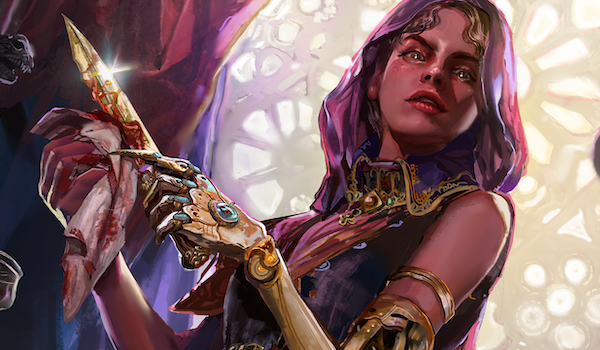
Creating and holding to such restrictive exercises can do wonders for both personal and format exploration, no matter the overall strength of a resulting deck and even if the excursion eventually leads to something outside its own parameters. Lately, the release of Thieves' Guild Enforcer led me to revisit Rogues, a deck that has long clamored for additional one-drops with which to enable Thieves' Fortune.
Rogues Through the Ages
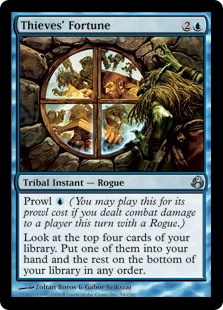
Rogues started out in a Temur shell running Humble Defector and employing a Splinter Twin package. With the enchantment's banning, it adopted Traverse the Ulvenwald and Kiki-Jiki, the latter providing a clunky combo that wasn't really what I wanted to be doing in the first place. Rogues lay dead in the water until Fatal Push and Fourth Bridge Prowler baited a switch to black from red as interactive colors. And I touched again on Rogues with the release of Robber of the Rich and the unbanning of Stoneforge Mystic, the pairing of which stretched the deck thin color-wise.
Out in Force
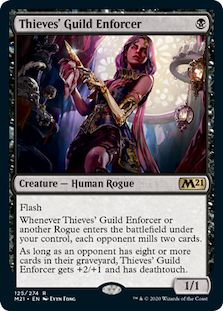 While Prowler was great in matchups featuring x/1s, it was far from the one-drop Rogues needed, which would be closer to Delver of Secrets but on-tribe; an aggressive creature with some form of evasion that clocked adequately in a pinch. Then came Thieves' Guild Enforcer, a card compact enough to apparently merit inclusion in some actual Delver decks: CHERRYXMAN maxed out on the Human to enable Vantress Gargoyle, so why shouldn't we use it for Thieves' Fortune?
While Prowler was great in matchups featuring x/1s, it was far from the one-drop Rogues needed, which would be closer to Delver of Secrets but on-tribe; an aggressive creature with some form of evasion that clocked adequately in a pinch. Then came Thieves' Guild Enforcer, a card compact enough to apparently merit inclusion in some actual Delver decks: CHERRYXMAN maxed out on the Human to enable Vantress Gargoyle, so why shouldn't we use it for Thieves' Fortune?
Enforcer has a number of legs up on Prowler. Once the eight-card condition is met, it swings like a flipped Delver, and with deathtouch to scare off blockers. Deathtouch is great on defense too, especially combined with flash; we can drop it into combat to take out a pesky fatty. Flash also gives us the choice between instants like Fatal Push or other options such as Spellstutter Sprite on an opponent's turn, rather than committing to playing a Rogue on our turn. Turn one Rogue can be nice to set up Fortune, but what if opponents then play Noble Hierarch? In that case, Push into Goyf tends to be a much sleeker line, and Enforcer gives us the most possible time to decide.
Sultai Rogues (Full Force Remix)
Here's where I landed:
Sultai Rogues, Jordan Boisvert
The Toolbox
With all that digging and tutoring, it pays to have a fleshed out toolbox.
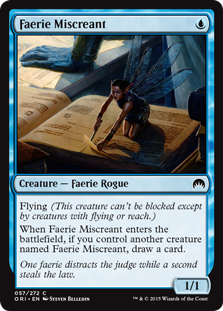 Fourth Bridge Prowler: A card that reinvigorated my Rogues project when it was spoiled, Prowler has indeed been demoted to bullet thanks to Thieves' Guild Enforcer, a far superior enabler for the deck. The card can still be a decent one-drop for some openers, but truly shines as a tutor target, where it shows up after blocks to finish off weakened Goyfs or pops out of the deck to handle Dark Confidant, Grim Lavamancer, mana dorks, and other troublesome x/1s.
Fourth Bridge Prowler: A card that reinvigorated my Rogues project when it was spoiled, Prowler has indeed been demoted to bullet thanks to Thieves' Guild Enforcer, a far superior enabler for the deck. The card can still be a decent one-drop for some openers, but truly shines as a tutor target, where it shows up after blocks to finish off weakened Goyfs or pops out of the deck to handle Dark Confidant, Grim Lavamancer, mana dorks, and other troublesome x/1s.
Faerie Impostor: I always liked two copies of Impostor in this deck, since when it's good, it's very good. That being said, it's certainly clunky when it's not good, and this build is tight enough for space that I went down to one. Still, re-using ETB effects is great here, and slamming Impostor with Cloak in play creates an impressive clock at the same time.
![]() Spellstutter Sprite: While not a Rogue, Spellstutter synergizes with a key enabler in Faerie Miscreant and gives us precious stack interaction. Grabbing Sprite for value in the mid-game is a great way to secure a lead.
Spellstutter Sprite: While not a Rogue, Spellstutter synergizes with a key enabler in Faerie Miscreant and gives us precious stack interaction. Grabbing Sprite for value in the mid-game is a great way to secure a lead.
Snapcaster Mage: We don't have that many instants and sorceries to hit with Snapcaster. When drawn naturally, the creature usually serves as an extra Traverse or Fatal Push. But in the deck as a Traverse target, Snap lets us re-use the bullets we dig for with Thieves' Fortune, which grants it tons of utility.
Scavenging Ooze: A late-game powerhouse and incidental grave hate for all stages of the game. Some decks absolutely have to remove this card to do their thing. Ooze hoses Uro, Snapcaster, other delirium decks and more.
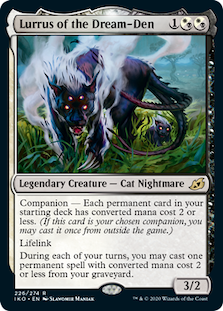 Brazen Borrower: Another excellent newcomer for the archetype, Borrower is itself a Rogue with flash, lending itself well to enabling Fortune. At the same time, it's a searchable bounce spell and multiple spells rolled into one card.
Brazen Borrower: Another excellent newcomer for the archetype, Borrower is itself a Rogue with flash, lending itself well to enabling Fortune. At the same time, it's a searchable bounce spell and multiple spells rolled into one card.
Lurrus of the Dream-Den: The sleeper best creature in the deck, and a major draw to Traverse strategies in black. Having access to a multi-use Snapcaster for permanents helps us win wars of attrition in the late-game, and we're already on 4 Bauble. Of course, that makes Lurrus better suited to shells like Jund Rock, but those lists are rarely equipped to run a Traverse package. That means we can benefit from Lurrus in those matchups.
Noncreature Bullets
Traverse the Ulvenwald won't find these bad boys, but thanks to Thieves' Fortune, they're never too far out of reach. As mentioned, boasting Snapcaster lets us semi-reliably use a key spell twice in a game.
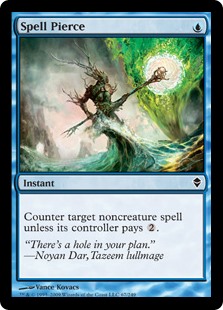 Spell Pierce: Pierce is just so good in Modern. The noncreature-heavy decks walk into it at all points of the game, be it with big planeswalkers or just generally big turns, and a naturally-drawn Pierce beaks up early plans like nobody's business. It's mostly just bad against Zoo-style decks, which are more or less nonexistent right now. Against Prowess, the format's closest analogue, countering Manamorphose or Light Up the Stage is the truth.
Spell Pierce: Pierce is just so good in Modern. The noncreature-heavy decks walk into it at all points of the game, be it with big planeswalkers or just generally big turns, and a naturally-drawn Pierce beaks up early plans like nobody's business. It's mostly just bad against Zoo-style decks, which are more or less nonexistent right now. Against Prowess, the format's closest analogue, countering Manamorphose or Light Up the Stage is the truth.
Unearth: Similar to Snapcaster, with some downsides and upsides: it can't be searched, but it provides a tempo boost. Also excellent with Snapcaster, not to mention Lurrus. Unearth represents a lot of options in the mid-game.
Collective Brutality: Early enabler or all-around role player, as needed. Extra copies in the side help us turn on lightning-fast in the matchups where Brutality dominates, like Burn.
Situating in Modern
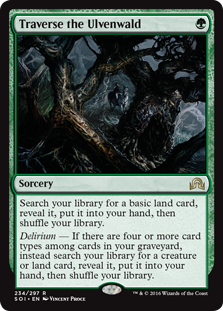 Not too long after I started messing around with Rogues again, Stormwing Entity came to be, which prompted a change of course that currently has me singing its praises in a different Traverse the Ulvenwald deck. The lesson from Rogues this time around is similar to the lesson from Rogues the first: the better deck tends to abuse the better card better.
Not too long after I started messing around with Rogues again, Stormwing Entity came to be, which prompted a change of course that currently has me singing its praises in a different Traverse the Ulvenwald deck. The lesson from Rogues this time around is similar to the lesson from Rogues the first: the better deck tends to abuse the better card better.
That fact of life has me second-guessing Delirium Delver—is the deck necessarily on an even keel with Traverse Shadow, Modern's other delirium exploiter? Natch, the only way to find out is to keep on grinding! How are your piles holding up, and what have you learned about your favorite cards in isolation? Let's keep the conversation going in the comments.




